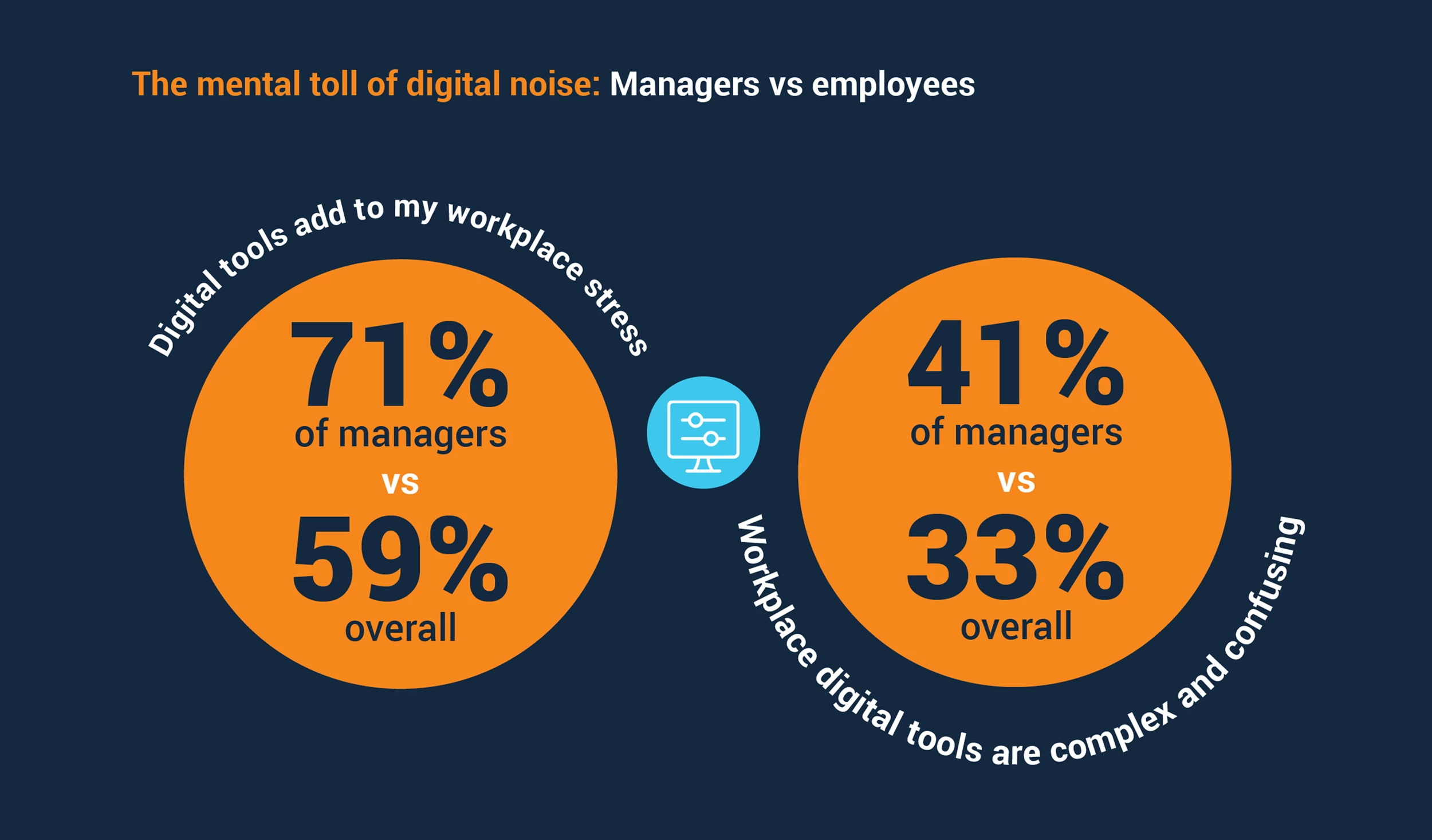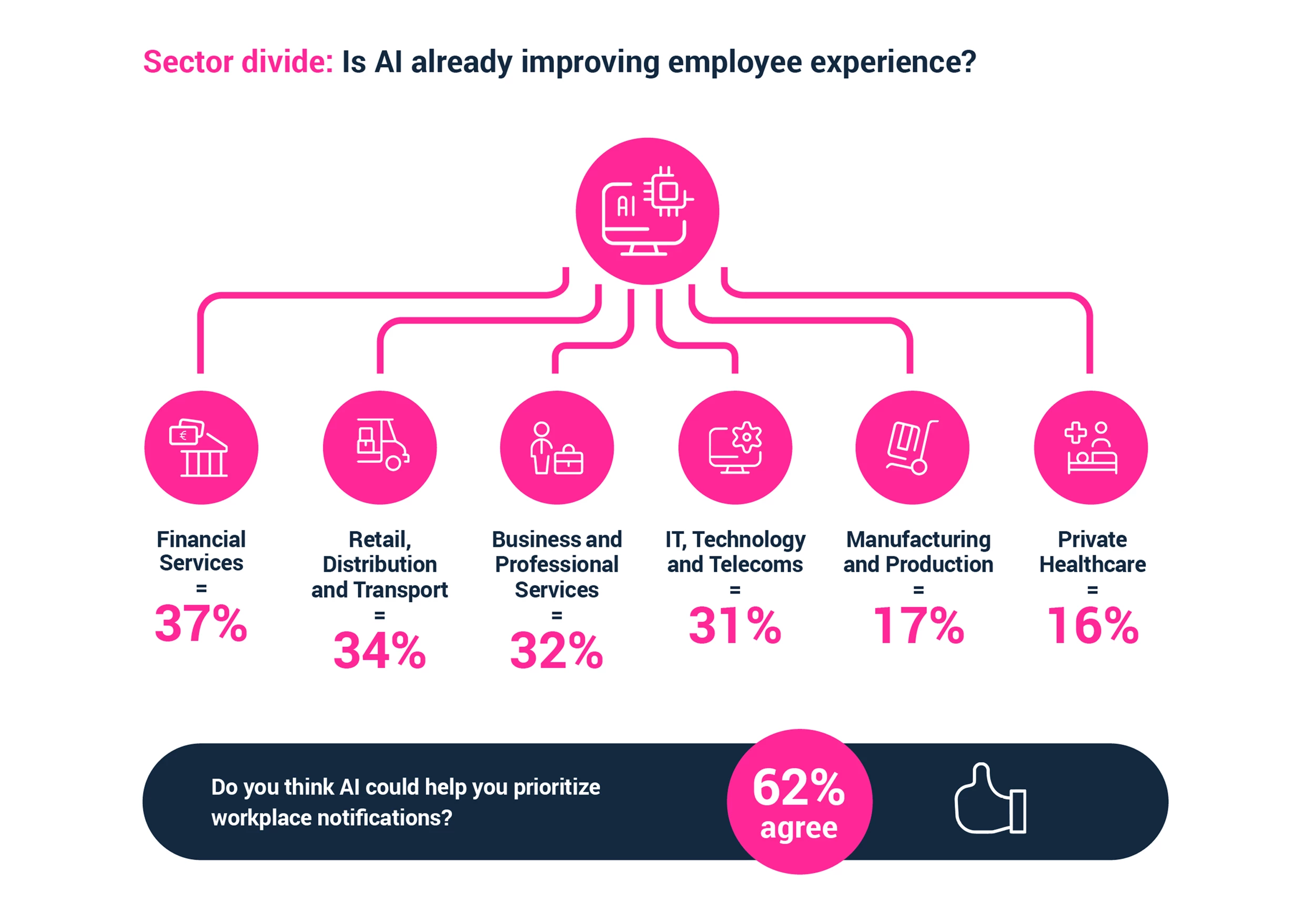Digital workplace research exposes workplace noise crisis
Unily’s new research highlights the negative impact of workplace interruptions caused by digital notifications on employee wellbeing and productivity. The majority of employees and managers agree that companies are not effectively addressing the issue of digital noise, draining businesses’ ability to stay competitive and adapt to today’s market driven by volatile economic fluctuations and technological advancements.

An opportunity to unify the disparate employee digital landscape
Unily’s latest digital workplace research highlights the negative impact of workplace interruptions caused by digital notifications on employee wellbeing and productivity. The majority of employees and managers agree that companies are not effectively addressing the issue of digital noise, draining businesses’ ability to stay competitive and adapt to today’s market driven by volatile economic fluctuations and technological advancements.
The rate at which workers report being distracted should be of critical concern to business leaders. Unily’s latest research report The ‘Digital Noise Impact Report’, shows that nearly half of all employees are distracted at least once every 30 minutes, and almost a third report being distracted at least once every 15 minutes by a workplace notification. That means employees working 8-hour days could be experiencing over 160 distractions from their workplace digital tools each week.
Tools designed to streamline tasks and enhance collaboration are having the opposite effect, with the constant barrage of notifications, messages, and updates, taking a toll on employees’ mental wellbeing and causing significant stress. Nearly six in ten employees report that digital tools add to their workplace stress, with the biggest contributors revealed to be video conferencing systems (44%), email platforms (39%), and instant messaging applications (36%).
In addition, employees and managers don’t think their companies are addressing the growing problem of digital noise in the workplace. Close to half of all managers and two in five employees believe companies aren’t implementing enough processes to combat the impact of digital noise, suggesting leadership isn’t taking the problem seriously enough.
"Our report delivers sobering findings on the impact of digital noise in today’s workplace, driving organizational lethargy and poor employee experiences. At the same time, we see some of the world’s largest and most complex organizations taking the opportunity to improve workplace engagement, with data showing the crucial role a simplified digital landscape and considered use of AI can play in reducing operational friction and increasing efficiency."
Distracting yet effective: a conundrum for leadership
Yet, despite the challenges that digital noise is causing, some of the tools are exceedingly viewed as effective in helping us do our jobs. Email, for example, was reported by 91% of respondents as effective in doing their jobs. Other effective tools include intranet and internal communications (84%), messaging platforms (83%), and video conferencing (80%).
The sheer number of digital tools integrated within the workplace means that employees have become dependent on them to complete most daily tasks. In fact, digital tools help workers feel more connected in the workplace, with nearly a quarter (73%) of respondents agreeing with this sentiment.
While many applications offer rudimentary on/off switches for their notifications, a total blackout may not be the answer. Nearly three in five (58%) believe that notifications have the potential to make them feel productive and informed.
The problem lies in how digital notifications interrupt workers mid-task, placing a tax on time and attention. That can impede their ability to handle context switching, fragmenting attention between tasks, applications, and screens. Unily’s data shows that two-thirds (67%) want more control over when and where they receive their notifications, highlighting the need for a smarter solution than a simple mute button.
Managers bearing the brunt
Managers also appear to be bearing the brunt of these distractions. Over 59% reported a digital noise distraction every 30 minutes or less, compared to 48% of all respondents, while 39% said they are distracted every 15 minutes or less, compared to 31% of all respondents.
"It’s clear that managers are hampered with more communications and channels, which exacerbates the problem of stress in the workplace. What’s more, this doesn't account for managers' added cognitive burden from constantly switching between tools. The fact that managers are feeling the strain of digital noise hardest is particularly concerning given that they have the biggest impact on a company’s employee engagement score."
The problem of digital noise was also found to be worse in the financial services sector, where 63% reported a distraction every 30 minutes or less, and 43% said they are distracted every 15 minutes or less.

AI and the superapp’s promise for distracted workers
Employees and managers alike crave more control over their digital environments. Most see AI-powered intranets and employee apps as a promising solution to consolidate tools, streamline workflows, and filter out noise. However, there’s a gap between AI’s potential and current implementation, highlighting an opportunity for organizations to invest in AI-driven solutions that enhance the employee experience.
A superapp strategy, which refers to a single application that brings all digital tools together in one place on all devices - including desktop, mobile, and digital signage -was supported by nearly all respondents.
When asked about the concept of a workplace superapp, 4 in 5 (83%) said it was a good or great idea. By embracing these 'superapps', employers can empower workers to manage their digital experiences more effectively, increasing focus, productivity, and overall job satisfaction. This is crucial to addressing the growing digital noise issue and building more positive, efficient workplaces.
Workers showed a resounding belief in the potential of artificial intelligence to help quiet the digital noise. Most (59%) believe that AI could reduce excessive notifications and prioritize notifications (62%), and nearly half (45%) believe their organization should deploy AI to do so. Despite its potential, however, the majority of respondents (51%) are not currently seeing improvements in their employee experience from AI.

Striking a balance
Today’s findings should spur organizations to prioritize a strategy that aims to reduce digital noise and improve the employee experience.
"The research reinforces what we’ve seen across the enterprise: the employee experience is suffering largely due to the crisis of digital noise in the workplace. While companies take on more digital apps to adapt to the new world of work, the resulting complexity and noise risks further disengagement and decreased productivity if not managed strategically. This jeopardizes an organization's ability to respond swiftly in the modern world of work."
Organizations have an opportunity to support their workforces with a clear strategy that aligns human resources and internal communications teams directly with their employees.
"What’s overwhelmingly clear from the data is that employees and managers alike believe that a superapp approach, supported by AI, can substantially improve their employee experience. At Unily, we’re dedicated to working with all HR, IT and internal communication teams to achieve this goal."
Research methodology
To learn more about the impact of digital noise on workers’ productivity and wellbeing, Unily partnered with global research agency Vanson Bourne to survey 500 respondents across the US and UK. Working for organizations with 5k+ employees, they came from the following sectors:
- Business and professional services
- Financial services IT, technology and telecoms
- Manufacturing and production
- Retail, distribution and transport
- Private healthcare
All datasets are anonymized and available on request.
Is your workforce drowning in a digital symphony?
Optimizing the employee experience is the pathway to success. For the full insight on how you can reduce noise, increase productivity, and decrease the velocity drain, download the guide here:
-
Guide
-
On-demand
















